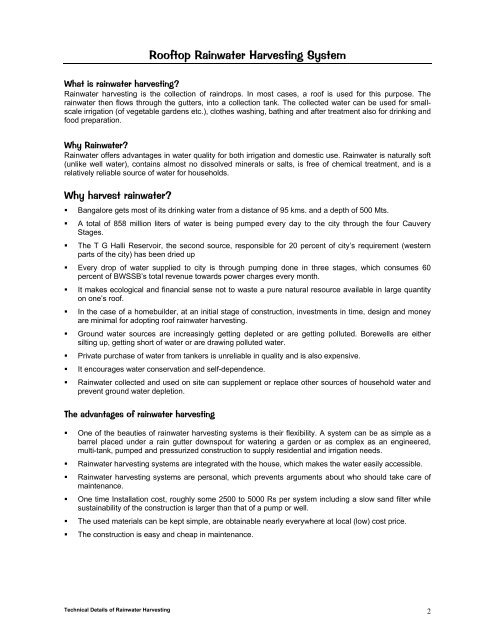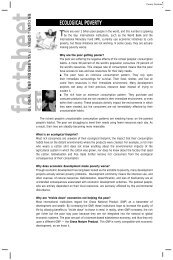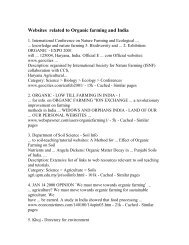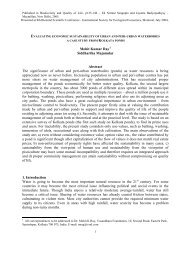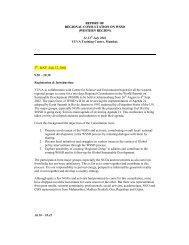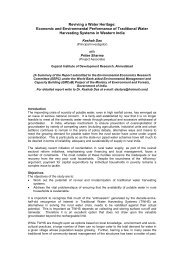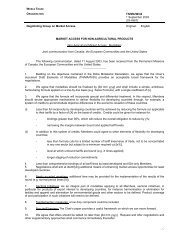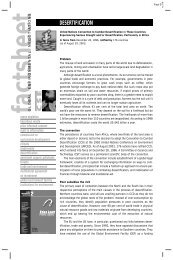Technical details - Rainwater Harvesting
Technical details - Rainwater Harvesting
Technical details - Rainwater Harvesting
Create successful ePaper yourself
Turn your PDF publications into a flip-book with our unique Google optimized e-Paper software.
Rooftop <strong>Rainwater</strong> <strong>Harvesting</strong> System<br />
What is rainwater harvesting?<br />
<strong>Rainwater</strong> harvesting is the collection of raindrops. In most cases, a roof is used for this purpose. The<br />
rainwater then flows through the gutters, into a collection tank. The collected water can be used for smallscale<br />
irrigation (of vegetable gardens etc.), clothes washing, bathing and after treatment also for drinking and<br />
food preparation.<br />
Why <strong>Rainwater</strong>?<br />
<strong>Rainwater</strong> offers advantages in water quality for both irrigation and domestic use. <strong>Rainwater</strong> is naturally soft<br />
(unlike well water), contains almost no dissolved minerals or salts, is free of chemical treatment, and is a<br />
relatively reliable source of water for households.<br />
Why harvest rainwater?<br />
• Bangalore gets most of its drinking water from a distance of 95 kms. and a depth of 500 Mts.<br />
• A total of 858 million liters of water is being pumped every day to the city through the four Cauvery<br />
Stages.<br />
• The T G Halli Reservoir, the second source, responsible for 20 percent of city’s requirement (western<br />
parts of the city) has been dried up<br />
• Every drop of water supplied to city is through pumping done in three stages, which consumes 60<br />
percent of BWSSB’s total revenue towards power charges every month.<br />
• It makes ecological and financial sense not to waste a pure natural resource available in large quantity<br />
on one’s roof.<br />
• In the case of a homebuilder, at an initial stage of construction, investments in time, design and money<br />
are minimal for adopting roof rainwater harvesting.<br />
• Ground water sources are increasingly getting depleted or are getting polluted. Borewells are either<br />
silting up, getting short of water or are drawing polluted water.<br />
• Private purchase of water from tankers is unreliable in quality and is also expensive.<br />
• It encourages water conservation and self-dependence.<br />
• <strong>Rainwater</strong> collected and used on site can supplement or replace other sources of household water and<br />
prevent ground water depletion.<br />
The advantages of rainwater harvesting<br />
• One of the beauties of rainwater harvesting systems is their flexibility. A system can be as simple as a<br />
barrel placed under a rain gutter downspout for watering a garden or as complex as an engineered,<br />
multi-tank, pumped and pressurized construction to supply residential and irrigation needs.<br />
• <strong>Rainwater</strong> harvesting systems are integrated with the house, which makes the water easily accessible.<br />
• <strong>Rainwater</strong> harvesting systems are personal, which prevents arguments about who should take care of<br />
maintenance.<br />
• One time Installation cost, roughly some 2500 to 5000 Rs per system including a slow sand filter while<br />
sustainability of the construction is larger than that of a pump or well.<br />
• The used materials can be kept simple, are obtainable nearly everywhere at local (low) cost price.<br />
• The construction is easy and cheap in maintenance.<br />
<strong>Technical</strong> Details of <strong>Rainwater</strong> <strong>Harvesting</strong> 2


